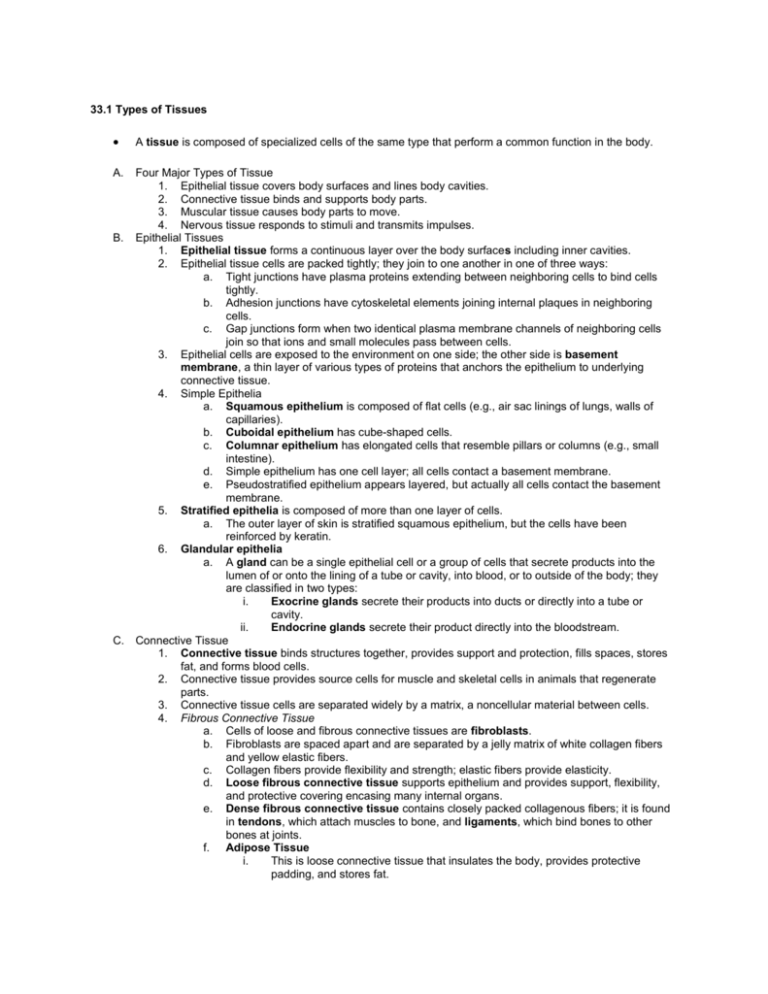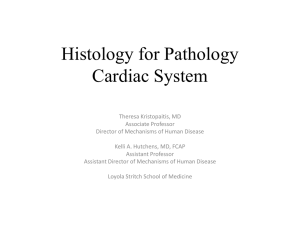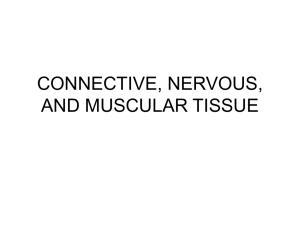33.1 Types of Tissues A tissue is composed of specialized cells of
advertisement

33.1 Types of Tissues A tissue is composed of specialized cells of the same type that perform a common function in the body. A. Four Major Types of Tissue 1. Epithelial tissue covers body surfaces and lines body cavities. 2. Connective tissue binds and supports body parts. 3. Muscular tissue causes body parts to move. 4. Nervous tissue responds to stimuli and transmits impulses. Epithelial Tissues 1. Epithelial tissue forms a continuous layer over the body surfaces including inner cavities. 2. Epithelial tissue cells are packed tightly; they join to one another in one of three ways: a. Tight junctions have plasma proteins extending between neighboring cells to bind cells tightly. b. Adhesion junctions have cytoskeletal elements joining internal plaques in neighboring cells. c. Gap junctions form when two identical plasma membrane channels of neighboring cells join so that ions and small molecules pass between cells. 3. Epithelial cells are exposed to the environment on one side; the other side is basement membrane, a thin layer of various types of proteins that anchors the epithelium to underlying connective tissue. 4. Simple Epithelia a. Squamous epithelium is composed of flat cells (e.g., air sac linings of lungs, walls of capillaries). b. Cuboidal epithelium has cube-shaped cells. c. Columnar epithelium has elongated cells that resemble pillars or columns (e.g., small intestine). d. Simple epithelium has one cell layer; all cells contact a basement membrane. e. Pseudostratified epithelium appears layered, but actually all cells contact the basement membrane. 5. Stratified epithelia is composed of more than one layer of cells. a. The outer layer of skin is stratified squamous epithelium, but the cells have been reinforced by keratin. 6. Glandular epithelia a. A gland can be a single epithelial cell or a group of cells that secrete products into the lumen of or onto the lining of a tube or cavity, into blood, or to outside of the body; they are classified in two types: i. Exocrine glands secrete their products into ducts or directly into a tube or cavity. ii. Endocrine glands secrete their product directly into the bloodstream. Connective Tissue 1. Connective tissue binds structures together, provides support and protection, fills spaces, stores fat, and forms blood cells. 2. Connective tissue provides source cells for muscle and skeletal cells in animals that regenerate parts. 3. Connective tissue cells are separated widely by a matrix, a noncellular material between cells. 4. Fibrous Connective Tissue a. Cells of loose and fibrous connective tissues are fibroblasts. b. Fibroblasts are spaced apart and are separated by a jelly matrix of white collagen fibers and yellow elastic fibers. c. Collagen fibers provide flexibility and strength; elastic fibers provide elasticity. d. Loose fibrous connective tissue supports epithelium and provides support, flexibility, and protective covering encasing many internal organs. e. Dense fibrous connective tissue contains closely packed collagenous fibers; it is found in tendons, which attach muscles to bone, and ligaments, which bind bones to other bones at joints. f. Adipose Tissue i. This is loose connective tissue that insulates the body, provides protective padding, and stores fat. B. C. ii. D. In mammals, adipose tissue is beneath the skin, around the kidneys, and on surface of the heart. 5. Supportive Connective Tissue a. Cartilage and bone are rigid connective tissues. b. Structural proteins (cartilage) or calcium salts (bone) are deposited in an intercellular matrix. c. Cartilage cells or chondrocytes lie in small chambers or lacunae embedded in a strong, flexible matrix. i. Hyaline cartilage is the most common type of cartilage; it is found in the nose, the ends of long bones and the ribs, the rings of the respiratory passages, and the human fetal skeleton. ii. Elastic cartilage is more elastic than hyaline cartilage; it is found in the outer ear. iii. Fibrocartilage has a matrix of strong collagen fibers; it is found in areas that must withstand tension and pressure (e.g., pads between vertebrae, knee joint). 6. Bone a. In bone, a matrix of calcium salts is deposited around protein fibers. b. Calcium salts give bone rigidity while protein fibers provide elasticity and strength. c. Compact bone has cells called osteocytes that lie within lacunae arranged in concentric circles within osteons (Haversian systems) around tiny tubes called central canals. d. These canals contain nerve fibers and blood vessels. e. Nutrients brought by the blood reach all of the cells via minute canals (canaliculi) containing thin processes of osteocytes that connect them with one another and with the central canals. f. Spongy bone at end of long bones is designed for strength, and has many long bony bars and plates. 7. FluidConnectiveTissue a. Blood transports nutrients and oxygen to cells and removes CO2 and wastes; blood also has a role in fluid, ion and pH balance and distributes heat. b. Blood is a connective tissue with cells separated by liquid plasma. c. In vertebrates, the blood cells are mainly of two types. i. Red blood cells (erythrocytes) carry oxygen. ii. White blood cells (leukocytes) aid in fighting infection. d. Platelets present in plasma are fragments of giant cells found in bone marrow and play a role in blood clotting. e. Lymph is a fluid connective tissue located in lymphatic vessels. i. Lymphatic vessels absorb excess tissue fluid and transport it to vessels of the cardiovascular system. ii. Lacteals, special lymphatic capillaries, absorb fat molecules from the small intestine. iii. White blood cells congegrate in the lymph nodes; lymph is cleansed as it passes through. Muscular Tissue 1. Muscular (contractile) tissue is composed of cells called muscle fibers. 2. Muscle fibers contain actin and myosin filaments; interactions result in animal movement. 3. The three types of vertebrate muscle tissue are skeletal, cardiac, and smooth muscle. 4. Skeletal muscle attaches by tendons to the bones of the skeleton. a. Skeletal muscle moves body parts, is under voluntary control, and contracts faster than other types. b. Skeletal muscle fibers are long, cylindrical, multinucleate cells arising from the fusion of several cells. c. Skeletal fibers are striated due to the light and dark bands of overlapping actin and myosin filaments. 5. Smooth (visceral) muscle is not striated. a. Spindle-shaped fibers form layers with the thick middle portion of one fiber opposite the thin ends of adjacent fibers. b. The nuclei form an irregular pattern in the tissue. c. Smooth muscle is not under voluntary control; it is therefore involuntary. d. Smooth muscle is found in the walls of viscera (e.g., intestine, stomach, etc.) and blood vessels. e. Smooth muscles drive the intestinal contractions and blood vessel constrictions. 6. Cardiac muscle is found only in the heart wall and powers the heartbeat that pumps blood. a. b. c. d. E. Cardiac muscle combines the features of both smooth and skeletal muscle. Unlike skeletal muscles with many nuclei, cardiac muscles have one centrally placed nucleus. Although it appears to be one mass of muscle fibers, the cardiac muscle fibers are individual cells. Cardiac muscle cells are bound end-to-end at intercalated disks where the folded membranes between two fibers contain desmosomes and gap junctions Impulses move from cell to cell so the heartbeat is coordinated. e. Nervous Tissue 1. Nervous tissue contains neurons in the brain, spinal cord, and nerves. 2. A neuron has three parts. a. Dendrites receive a stimulus and conduct signals to the cell body. b. The cell body contains most of the cytoplasm and the nucleus of the neuron. c. The axon conducts nerve impulses away from the cell body; long axons are covered by myelin. d. Long axons and dendrites form neuron fibers; bound together by connective tissue, they form nerves. e. Outside the brain and spinal cord, fibers bound by connective tissue form nerves. 3. Neuroglia a. There are several types of neuroglia in the central nervous system. b. Neuroglia outnumber neurons 50 to 1, and were once thought to only support or nourish neurons. c. Microglial cells support neurons and also phagocytize bacterial and cellular debris. d. Astrocytes provide nutrients and produce a growth factor known as glia-derived growth factor that someday may be used to cure diseases of neural degeneration. e. Oligodendrocytes form the myelin around an axon. f. Neuroglia lack long processes but communicate among themselves and with neurons. 33.2 Organs and Organ Systems Organs are combinations of two or more different tissues performing common functions. 1. B. C. An organ system contains many different organs that cooperate to carry out a process (e.g., digestion). 2. The integumentary system is composed of the skin and accessory organs (i.e., nails, hair, glands, and sensory receptors). Skin as an Organ 1. Human skin protects the underlying tissues from trauma, desiccation, radiation damage, and microbial invasion. 2. The skin produces a precursor molecule that is converted to vitamin D after exposure to UV light. 3. The skin also helps regulate body temperature. 4. Laden with sensory receptors, the skin collects information about the external environment. Regions of Skin 1. The skin has both an outer epidermal layer (epidermis) and a deeper layer (dermis); a subcutaneous layer (hypodermis) is found between the skin and underlying structures. 2. The epidermis is the outer, thinner layer of skin. a. The epidermis is composed of stratified squamous epithelium. b. Epidermal cells are derived from the basal layer of stem cells that undergo continuous cell division underneath. c. The newly formed cells push to the surface away from their blood supply; they flatten and harden as they accumulate keratin, a hard, waterproof protein. d. Eventually, the keratinized cells die and are sloughed off. e. Melanocytes located in the basal layer produce a melanin pigment that absorbs UV light, protecting deeper cells from radiation damage; certain cells in the epidermis convert a steroid related to cholesterol into vitamin D, a chemical required for proper bone growth. f. Skin Cancer i. Too much ultraviolet radiation is dangerous and can lead to skin cancer. ii. Excessive exposure to UV radiation can convert cells in the basal layer of the epidermis into cancer cells (basal cell carcinoma); melanoma is skin cancer derived from melanocytes. 3. The dermis is fibrous connective tissue that forms a thicker and deeper layer of skin. a. D. E. The dermis contains both elastic fibers and collagen fibers; these run parallel with the skin surface. b. The dermis contains blood vessels that can constrict and dilate. c. Many small sensory receptors are present in the dermis. i. There are separate receptors for pressure, touch, temperature, and pain. 4. The subcutaneous layer is not technically a part of the skin; it is composed of loose connnective tissue and adipose cells, which store fat. a. The subcutaneous layer lies below dermis. b. This is composed of loose connective tissue, including adipose tissue. c. Adipose tissue helps insulate the body by minimizing both heat gain and heat loss. d. This layer of adipose gives a rounded appearance to the body. e. The excessive development of adipose tissue occurs with obesity. Accessory Organs of the Skin 1. Nails grow from special epidermal cells at the base of the nail in a region called the nail root. a. The visible portion of a nail is the nail body. b. Cells become keratinized as they grow out over the nail bed. c. The vascular dermal tissue under the nail provides the pink color; the white half-moon area is the thicker germinal area. 2. A hair follicle contains a nonliving hair shaft and the living hair root that produced it. a. The hair shaft is formed of dead, keratinized epidermal cells that protect the surface of the skin. b. The arrector pili muscle is a smooth muscle attached to the hair follicle; contracting it causes the hair to erect. c. Follicles have oil (sebaceous) glands producing sebum, an oil secreted to lubricate both the hair and the skin. 3. The sweat (sudoriferous) glands are coiled tubules present in most of the regions of skin that secrete a fluid (sweat) onto the surface of the skin. Organ Systems o In most animals, individual organs function as part of organ systems. o The organ systems carry out life processes common to organisms. 3. Body Cavities a. The human body has two main cavities: the dorsal cavity holds the brain and spinal cord, and the larger ventral cavity. b. The ventral cavity located on the front side of the body develops from the coelom and is divided by a muscular diaphragm in humans and other mammals. c. The upper (thoracic or chest) cavity is located in the upper part of the ventral cavity, above the diaphragm, and contains the heart and lungs. d. The lower (abdominal) cavity is located in the lower part of the ventral cavity; it contains the major portions of the digestive and excretory systems, and much of the reproductive system. 33.3 Homeostasis The cells of the body live in an internal environment, tissue fluid that bathes the cells of an animal's body. 1. This concept was first proposed by Claude Bernard, a famous French physiologist in 1859. 2. The internal environment (e.g., composition and temperature) must stay within normal range. 3. This relative internal stability allows animals to tolerate considerable external variation. 4. The American physiologist Walter Cannon first used the term "homeostasis." Homeostasis is the maintenance of internal conditions in a cell or organism by means of self-regulating mechanisms that curtail fluctuations above and below a normal range. 1. The organ systems of the human body contribute to homeostasis. a. The respiratory system adds oxygen and removes carbon dioxide; the amounts are altered to meet needs. b. The liver removes and stores glucose as glycogen and then replaces the blood glucose levels when they lower. c. The hormone insulin is secreted by the pancreas to regulate glucose levels. d. The kidneys are under hormonal control to excrete wastes and salts and to maintain blood pH. 2. Although homeostasis is controlled by hormones, it is ultimately controlled by the nervous system. 3. The brain contains centers that regulate temperature and blood pressure. 4. A. B. Regulation requires a receptor that detects unacceptable levels and signals a regulator center that can direct an adaptive response; once normalcy is obtained, the receptor is no longer stimulated. Negative Feedback 1. A negative feedback mechanism involves a response in which a variable is kept close to a particular set point. a. The process involves a sensor and a control center. b. The sensor detects a change in the internal environment. c. The control center brings about an effect to bring conditions back to normal. d. Example: the pancreas detects that the blood glucose level is too high; it secretes insulin which causes cells to take up glucose; blood glucose level returns to normal. e. A home heating system is a mechanical example of a negative feedback mechanism. f. HumanExample: Regulation of Body Temperature i. The sensor and control center are located in the hypothalamus. ii. When body temperature is above normal, the control center directs blood vessels in the skin to dilate—heat is lost to the environment. iii. When body temperature is below normal, the the control center directs blood vessels in the skin to constrict—heat is conserved in the body. Positive Feedback 1. A positive feedback mechanism involves output that intensifies and increases the input, thereby increasing the process; an ever-greater change in the same direction occurs. 2. Once childbirth begins, each event amplifies; the process continues until birth occurs. 3. Positive feedback mechanisms can be harmful, e.g., when a fever causes metobolic changes that push the fever even higher.








